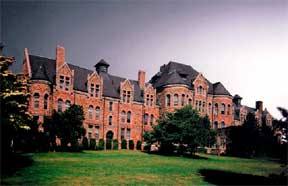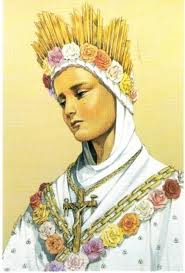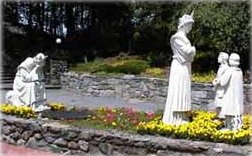The Shrine of Our Lady of La Salette, Attleboro, Massachusetts
What qualifies as a place of healing? And furthermore, where is there one within a navigable and not-too-far a distance away from Providence, Rhode Island? Neither Google nor Bing returned good search results without some extra digging. Holistic grocery and supply stores didn't exactly qualify. An article advertising the Spa at the Norwich Inn claimed it had Native American owners, but failed to promise any type of healing other than cosmetic and relaxation treatments found at any other spa. That led me to do a Native American search, which yielded the National Kateri Tekakwitha Shrine, which enshrined a young Mohawk girl who fled to a Christian village, where she was baptized in a spring whose waters have supposed healing properties for pilgrims who venture out to Fonda, New York.(Kateri Shrine Website 2003-2012). A four-hour drive was a bit much, though.
Another shrine much closer proved to be both appropriate to the topic and interesting in its history and development. The National Shrine of Our Lady of La Salette in Attleboro, Massachusetts had a history that comprised not only a natural spring – typical of natural places of healing – but also had been the site of a turn-of-the-century sanatorium planned and erected by a “healer” of the time. The site is presently an expansive pilgrimage destination, established by French missionaries in 1953, after the grounds had served as a seminary for about a decade (National Shrine of Our Lady of La Salette Brochure). From the website, La Salette seemed to cover several categories of places of healing: the unusual geology of a spring; a built therapeutic environment designed to facilitate healing of medical conditions; and a spiritual site of pilgrimage connecting believers’ bodies with a physical place and story.
James Solomon and his Sanatorium
At the end of the 19th century, James Solomon was a known herbalist, and though he was referred to in and around Attleboro as “Dr. Solomon” or as an “Indian Doctor,” he was neither Native American, nor did he have any official medical training. He hoped to one day build a sanatorium for cancer patients on the grounds where he collected herbs and roots (La Salette 2010, Simmons 2012). The timeline on La Salette’s website states Solomon’s dream eloquently: “…here people would come from all corners of the world to be healed…cured of that dread disease, cancer” (La Salette 2010). Plans for the sanatorium began in 1894, and walls stood by mid-1901. A lack of funds stalled the project until a local businessman, John M. Fisher, agreed to fund the project to completion. The Sanatorium was opened on April 25, 1903, with great fanfare in Attleboro.

The 200-room “castle” had cost $400,000 to build, and was fully electrified (Simmons 2012, Paradis). The first patients were admitted in May 1903, with Herbert B. Horton, M.D. serving as “house physician” (La Salette 2010).
What followed Solomon’s realized vision for a place of healing were perpetual financial problems and a seeming revolving door of owners and administrators. The Solomon Sanatorium closed in 1906, to be reopened two years later by the Nicola family from Battle Creek, Michigan, whose mission “for the relief of suffering humanity” continued until 1918, when one of the Nicola doctors “mysteriously disappeared” during a vacation. Ownership transferred to the Methodist Board of Foreign Missions, whom John Fisher enlisted to reinvigorate the newly christened Attleboro Springs Sanatorium (trying with the title to invoke society’s equation of natural springs with healing properties – though there remained no explicit reference to springs on the grounds). Further financial instability forced the Methodists to cease operations in 1924. They succeeded in convincing the New England Deaconess Association to take over the Sanatorium in 1927. An organization already heavily involved caring for the “suffering and needy” that founded and operated hospitals in Boston and Concord (Deaconess Abundant Life Communities 2012), the Deaconess Association spent $30,000 renovating and restoring Attleboro Springs. The Sanatorium’s final patron was Thomas J. Griffin, a businessman who invested in the Sanatorium to implement new medical programs, but his investments also failed, with the final closing of the institution occurring on January 1, 1938 (La Salette 2010).
The Missionaries Take Over
The Missionaries of Our Lady of La Salette originated in the French town of the same name, where, on September 19, 1846, two young peasant children (Maximin Giraud and Melanie Mathieu, aged 11 and 14, respectively) saw a vision of the Virgin Mary. The small tract given out at the Shrine today describes the apparition unfolding after the two children jolted awake from a nap, worried that their cows had wandered off. Finding the cows at the top of a hill, they turned around and saw a bright light, then distinguished a crying woman, seated on the bench where they had eaten lunch. Their description of her produced this image:

Mary’s message to the children admonished the sinfulness of the world and begged for its reconciliation. After commissioning the children to “make this known to all my people,” Mary ascended into heaven and vanished. Five years later, the Bishop of Grenoble affirmed the apparition as legitimate: “the vision shows all the signs of truth and the faithful have grounds for believing it indubitable and certain” (National Shrine of Our Lady of La Salette, Apparition).
The missionaries of La Salette formed in 1852, some of whom arrived in the United States in 1892. They came to Attleboro in 1942, when they purchased the defunct sanatorium for use as a seminary (Paradis). Ten years later, a Shrine to Our Lady of La Salette was dedicated in Attleboro, coinciding with the beginning of the “Marian Year” of 1854, marking the centennial of the dogma of the Immaculate Conception, established by Pope Pius IX in 1854. 10,000 people attended the dedication services, which included fireworks, an outdoor nativity scene, and a Christmas festival of lights (La Salette 2010). This Christmas festival has become a tradition that continues today at the Shrine, touted by the Providence Journal as “one of the most elaborate Christmas displays on the Eastern seaboard” (Providence Journal 11 November 1999).
Expansion of the site continued through the 1960s and 1970s. The campus grew to include a monastery, cafeteria, gift shop, offices, classrooms, and a spiritual retreat center. The Christmas Festival of Lights remains the Shrine’s biggest draw, with over 300,000 lights illuminating the Shrine and its grounds for over 500,000 yearly visitors. The U.S. Conference of Catholic Bishops granted the Attleboro shrine official national status in November 2003 (La Salette 2010).
In 1999, the old sanatorium – in the meantime dubbed “the castle,” and officially “Provincial House” – burned down, with visiting priest Father Paul O’Brien losing his life in the blaze. The decision was made not to reconstruct the sanatorium building, since a new church building was already under construction. The current visitors’ center, pictured at the top of this page, was completed in 2007 (La Salette 2010).
My Visit: A Site Devoid of its History
The impression that a visitor (or at least this visitor) gets when visiting La Salette is purely religious, and at times awkwardly commercialized (a poster for 24 flavors of soft-serve ice cream hangs on the entrance sign). The massive parking lot suggests overwhelming visitation, but on a Sunday in late September, visitors were sparse. Because most of the buildings are so new, the complex exudes a sanitized aura; the sanctuary and the Chapel of Light (below) are stark and somewhat cold in their decoration.
Since the destruction of the Sanatorium building, no trace of the history of physical healing at the site remains. Although the Shrine offers Healing Services one Sunday a month in English, Portuguese, and Spanish, they are purely faith-based.
The outdoor elements of the Shrine coincide more with attributes of healing places we have discussed. While the natural springs are not alluded to in any way, water plays a central role in several installations, as does physical landscape. The Rosary Walk (above) circumscribes a pond with fountains, and the central Marian figure at the center of the Rosary stands atop another fountain. Furthermore, the sculptural garden and “Holy Stairs” allow pilgrims to physically exert themselves while climbing the hill showing the stations of the Apparition (below), as well as to ascend the stairs (suggested on one’s knees) to pray in the shadow of the scene of the crucifixion, somewhat concealed in a forest grove.

Finally, a peaceful outdoor chapel allows for quiet contemplation (if you can block out the musak-y renditions of hymns and other religious tunes). I remained puzzled by the lack of acknowledgement of the springs. “Our Lady’s Fountain” (below) in the outdoor chapel subtly suggested a natural spring, with the water coming out of a rock, rather than manufactured jets as in the Rosary Pond.
It seems that the Shrine sought to incorporate some of the natural elements of healing places and the attributes that drew James Solomon to found his sanatorium on that site, without explicitly referencing or drawing attention to them. The sanatorium's story is told in great detail on both the Attleboro Shrine’s website and the general La Salette website, but on location, faith is the only topic addressed.
The Sanatorium “Castle” remains in public memory, however, even if perhaps not explicitly as a sanatorium. A Providence Journal article in the wake of the fire described it as “the place where some people realized their vocations as seminarians, or experienced renewal on retreats. Many in town simply loved the building for its beauty, and slowed to admire it as they drove or jogged past” (Providence Journal 1999).
One additional interesting component to the Shrine were the “Ethnic Pilgrimages” offered throughout the year. Ranging anywhere from Irish-American to Catholics from India, specific groups are encouraged to conduct a pilgrimage together. In light of Arturo Escobar and Arjun Appadurai’s discussions of trans-national communities or neighborhoods, this encouragement to identify in a particular way to the site and to other people raises questions about the properties of spirituality in the context of a supposed “more culturally homogenous” group. At the same time, the calling of so many diverse groups maintains the universality of the salutary and saving message of the Apparition of La Salette.
Conclusion
This site in Attleboro has shifted over the last century from a place of natural healing, to medical practice, to a place of spiritual renewal. Individuals’ definition of the environment made shifts from natural to supernatural. The later name "Attleboro Springs" may have, in fact, been constructed simply to connote the natural healing geology, without any physical evidence of such a spring existing. While there is also no longer reference to the medical history of the sanatorium, or even physical evidence since the 1999 fire, the site today only purports to be a religious location. The exclusion of stories of the sanatorium and the site’s history indicate a desire on the part of the Shrine to focus on their priorities: spiritual fulfillment and healing. Pilgrimages often serve to reinvigorate and strengthen faith, perhaps serving to realign a person’s beliefs through experiencing them in a different and intentional physical context. Although my visit as a lately skeptical Christian (although not Catholic) left me analyzing the site's ambivalent history and commerciality, the site’s impact assuredly increases with the addition of a few thousand pilgrims or Christmas visitors. The power of the story and the faith that surrounds it must necessitate a greater reverence and aura than my friend and I experienced on our Sunday morning visit. I ask myself if or how the site might retain the layers of history and healing associated with it without explicit acknolwedgement in the Shrine's present incarnation. Instead of adding to the heritage of healing, it appears that without the sanatorium structure, the Shrine has taken on a new image, beginning and ending with their religious mission communicated through the La Salette Apparition.
References
Deaconess Abundant Life Communities; 2012. “Our History.” [link]
Kateri Shrine Website; 2003-2012. http://www.katerishrine.com/
La Salette, Province of Mary, Mother of the Americas; 2010. “La Salette in Attleboro, MA.” [link]
National Shrine of Our Lady of La Salette. The Apparition of Our Lady of La Salette (pamphlet).
A Place and Message for our Times (brochure).
Paradis, Rev. Donald. “Our History – History of the National Shrine.” National Shrine of Our Lady of La Salette, Attleboro, MA. [link]
Providence Journal; 11 November 1999. “Can this treasure be saved?”
Simmons, Bryan; 2012. “La Salette Seminary, Attleboro Springs Sanatorium.” The Historical Marker Database. [link]
